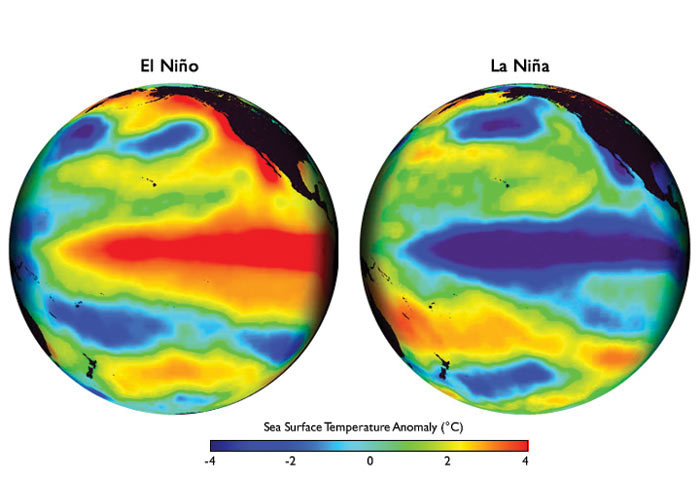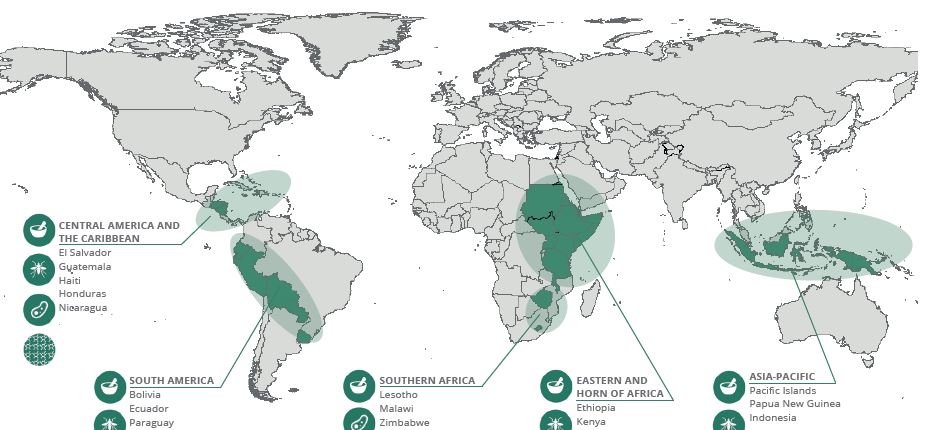- Ocean Current
- Huge water movements across the oceans carrying properties such as temperature.
- Convectional rainfall
- A type of rainfall where heated air rises, cools and condenses. Heavy rains occur along warm waters due to moisture supply.
El niño, which is a Spanish word for little boy is a short term climatic change which involves the reversal of trade winds in the Southern Pacific ocean. It is sometimes known as ENSO (El niño Southern Oscillation) and occurs after 3-5 years or even after a decade and has an adverse impact on the weather across the world.
How it Occurs
Under normal conditions, air is heated, rises and cools on the Western Pacific along countries like Indonesia and Philippines. This creates a low pressure with heavy convectional rainfalls along the Western Pacific. In addition, surface water is also pushed west (LP) by strong trade winds from the East (HP) due to pressure differences.
The raised air continues to travel eastwards and descends on the Eastern Pacific along Peru, Chile, Ecuador etc. This creates a high pressure with dry conditions. This high pressure zone results in the upwelling of cold ocean water which summons fish to the surface.
This cold water is also rich in plankton (small microscopic organisms). The surface air continues to move west and rises again and the circulation continues. This circulation is known as the Walker Circulation.
 El Niño
El Niño La Niña
La NiñaHowever, during El niño air movement changes direction from west to east and surface trade winds from east to west resulting in low pressure conditions along the East.
Strong heating in the east raises air which cools and creates heavy convectional rainfalls. Surface water is also pushed east by strong trade winds raising ocean waters.
The raised air now descends along the Western Pacific generating high pressure conditions characterised by very low rainfalls. The air, now on the surface, moves again towards the east (or in reverse direction) and rises and the cycle continues until La Nina which breaks this cycle and returns the normal one.
Warm ocean waters along the EP is nutrient poor, thus poor fish yields. This strong warm (surface) ocean current travels to the west or can reverse direction.
Under La Nĩna low pressure intensifies on the West and high pressure strengthens on the East Pacific.
| Western Pacific | Eastern Pacific | |
|---|---|---|
| El Nino | Dry | Wet |
| La Nina | Wet | Dry |
 Ocean Temperatures during El-Niño & La Niña; source Skymetweather
Ocean Temperatures during El-Niño & La Niña; source SkymetweatherEffects
El niño has adverse effects across the globe especially the Southern Hemisphere (S.E South America, Australasia, Oceania, Southern Africa and Antarctica).
East South America experiences low pressure conditions with torrential rainfalls and high temperatures during El nino. Deserts such as the Atacama flourish with water and plants bloom. River discharges increase in major basins such as the Amazon. This heating along S.E Pacific also affects adjacent regions such as Southern and Centaral US bringing hurricanes and rainfalls to areas like Texas, New Orleans & Florida. Local heating can trigger tornadoes.
Southern Africa is in the subtropical region and typically dry, thus El niño causes more dry spells in this region especially during the rainy season. Vector borne diseases like malaria are rampant.
Monsoon rainfalls of India fails or delay with the approach of El Niño. The entire S.W Pacific is heavily affected with very poor rains, high temperatures, food shortages & malnutrition, vector borne diseases and many others.
Europe is least affected because of its vicinity from S.E Pacific. Ice sheets in Antarctica melt raising sea waters in the process which can encroach land leading to coastal floods.
 Some areas affected by El Nino; source WHO
Some areas affected by El Nino; source WHOAlthough rainy, high temperatures are also present in the East Pacific.
Effects to the South East Pacific
- High rainfalls in areas like Peru, Ecuador and Bolivia leading to flooding and flash floods in the Atacama deserts
- Hurricanes
- Heat Waves
- Melting of ice capped mountains; Avalanche risks
- Water borne diseases
- Vector borne diseases e.g malaria, zika, chikungunya.
- Food shortages and malnutrition
- Fishing is much reduced since the water is warm lacking nutrients and plankton for the fish
Effects to S.West Pacific, Indo-Australian, Southern Africa
- Droughts and famines
- Heat waves
- Water bodies such as groundwater, lakes and dams deplete or dry out.
- Vector borne diseases e.g malaria and dengue.
- Cancers, rushes and strokes
- Acute food shortages & malnutrition
- Risk of Brush/ Wild fires
- Monsoons delay e.g India’s monsoon
- Rift Valley fever
Antarctica
- Melting ice sheets
- Sea level rises and can encroach land
North America
- Melting ice
- High temperatures and dry conditions in USA and Canada
Central America & The Caribbean
- Hurricane risks in Southern US e.g New Orleans and Florida
- High temperatures and drought in countries like Haiti and Jamaica
- Cholera and diarrhoea in The Caribbean
